Requiem for the Suicided: Terrance Yeakey
Published: March 11, 2023
FROM 2010: This week we turn the focus of our open source investigation to Sgt. Terrance Yeakey, one of the first responder heroes at the scene of the OKC bombing who discovered something that conflicted with the official story of the bombing...something that cost him his life.
Who Murdered Oklahoma City Police Sgt. Terrance Yeakey
- By Pat Shannan - 1997
Oklahoma City False Flag Bombing Of Albert P. Murrah Federal Building took place on April 19, 1995, orchestrated by the terrorist, murderers United States federal government and the parasite ruling class. This is the only logical conclusion one can reach after calm analysis of the facts.
The case of Oklahoma City police sergeant: Terry Yeakey, 6-foot, 3-inch, nearly 300-pound, bright selfless man, an American hero, who worked for 48 hours without sleep, performing many rescue missions.
Terry Yeakey was a giant of a man with a heart as big as the rest of him. I wish I had known him. He was a crusader for truth. Whenever his name is mentioned, I think of the news photo of him sprinting down NW 5th Street toward the Murrah Building on another of the many rescue missions he performed that ugly day. In his blue uniform, he tends to remind us of a NFL linebacker about to put the sack on an unfortunate quarterback, but this is quickly overridden by the grave concern on the face of a policeman in a panic to save lives.
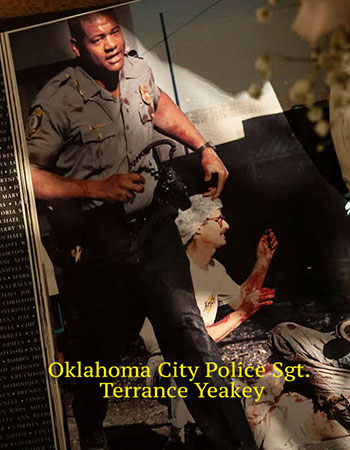
After numerous private investigators produced irrefutable evidence of multiple explosions, unexploded bombs being hauled away after the fact, and the complete and total incapability of an Ammonium Nitrate Fuel Oil (ANFO) bomb to cause the cause the kind of devastation seen in downtown Oklahoma City, a giant government cover-up became obvious.
Only a couple of hours into the rescue, Sgt. Terrence Yeakey became painfully aware of something disturbing. Did he somehow figure out that the building had been blown from the inside and that the news reports were baloney? Did he overhear a strange conversation from some of the many ATF agents who were on the scene sooner than they should have been? Whatever it was, Terry was upset. He called his wife that morning crying - the big ol' Teddy Bear of a guy was crying - and saying repeatedly, "It's not true. It's not what they are saying. It didn't happen that way." Terry Yeakey may have been the first to discover the sham.
He ran back and forth into that concrete mess of bricks and mortar all day long and continued beyond exhaustion, far into the night. He scraped and crawled and dug until his fingers bled and then kept digging some more. In a cadre of heroes that day, Terry's performance was outstanding. On May 11th, 1996 the following year he was scheduled to receive the Medal of Valor from the Oklahoma City Police Department. He never got it. He was murdered on May 8, 1996, in the country - two and a half miles west of the El Reno Penitentiary.
The official report said "Suicide," and anyone who believes an ANFO bomb destroyed Murrah and the other surrounding buildings will believe this. According to the report, Terry slashed himself eleven times on both forearms before cutting his own throat twice near the jugular vein. Then, apparently seeking even a more private place to die, he crawled another mile of rough terrain away from his car and climbed a fence, before shooting himself in the head with a small caliber revolver. What appeared to be rope burns on his neck, handcuff bruises to his wrists, and muddy grass imbedded in his slash wounds strongly indicated that he had some help in traversing this final distance.
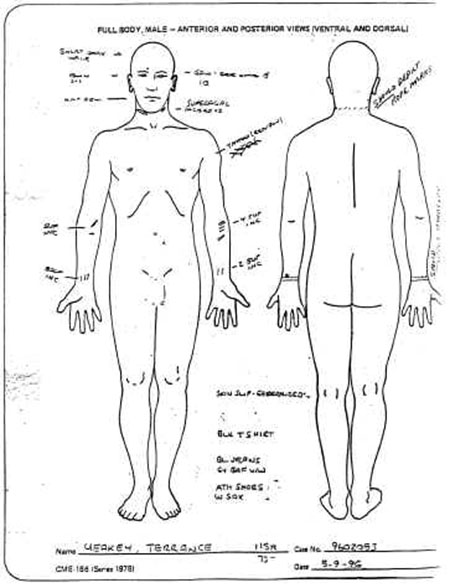
The bullet's entrance wound was in the right temple, above the eye. It went through the policeman's head and exited in the area of the left cheek, near the bottom of the ear lobe line. The trajectory was from a 40-45 degree angle above his head. There were no powder burns. No weapon was ever reported as found at the scene, but independent investigators speculated that had Yeakey shot himself with standard police issue - a Glock 9mm or a .357 Magnum - his head would have been far more destroyed than it apparently was.
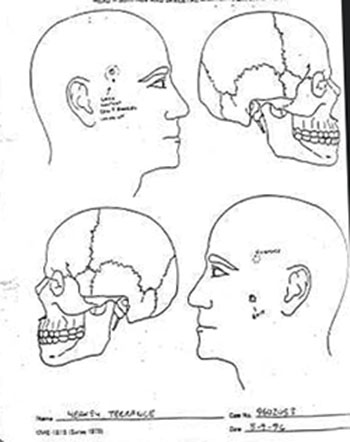
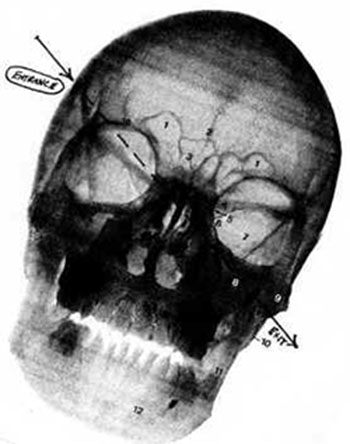
Example of skull xray showing downward path of bullet exhibited in Yeakey's autopsy drawing.
One of the last people Officer Yeakey talked to was a friend who knew he was on a mission of private investigation. Terry had told him that he was on his way to El Reno to check out something but first he had to shake the FBI agents who were following him. He was traveling in his private automobile, and witnesses said later that the inside looked like someone had "butchered a hog" on the front seat.
While political assassinations within American borders have become more prevalent in recent years, the ploy to place the blame on someone else - even the victim himself - is nothing new. Neither is the gullibility of the American public.
Although the Yeakey incident occurred some thirty miles away in a different jurisdiction, the investigation was quickly taken out of the hands of the El Reno police and the Canadian County sheriff and turned over to the Oklahoma City Police Department and the FBI. No homicide investigation was ever conducted, and there was no autopsy.
In an interview with Terry's widow, Tonia Yeakey revealed that her husband had been very upset by something he had seen under the day care center on April 19th. He had wanted to go back and photograph it, but the officials would not let him onto the site again. The Oklahoma Bombing Investigation Committee (OKBIC) speculates that what Terry saw may have coincided with the possible evidence of another unreported bombing device uncovered by their "science people."
Mrs. Yeakey also said that Terry was supposed to be decorated for his work as a rescue person, but didn't want to be put in the limelight. Terry felt the investigation was fraudulent and didn't like the fact that the OKPD was honoring people who really weren't deserving of the honor.
Sgt. Yeakey had told friends that he was going out of town to hide or secure "evidence of a cover-up of the bombing by federal agents." It was his day off, and he was traveling in his private automobile. In his last known conversation, Terry reportedly told a friend that he "was being followed by the feds and had to shake them." Previously, his household had been subjected to numerous threatening phone calls by persons unknown, threats which have not ceased even with his death.
Tonia Yeakey moved five times in the first three years since the Oklahoma City tragedy. She continues to get intimidating letters and threatening phone calls. Since her husband's death, her home has been broken into and personal threats have been written on her living room walls. She remains in fear for her life, constantly seeking asylum, with no place to turn.
Sgt. Terry Yeakey was murdered, and just as with the absurd conclusions in the Vince Foster case, the closing of the case as a "suicide" is ludicrous.
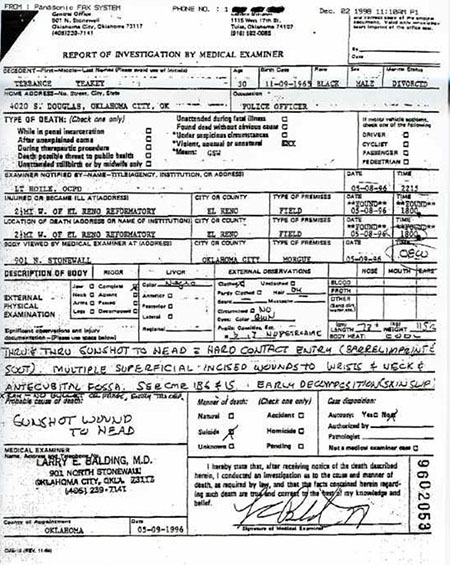
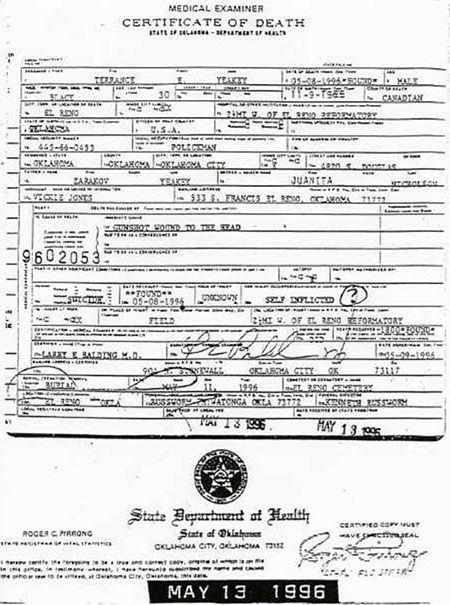
Webmaster's note: All the autopsy evidence shows that Yeakey's wounds were consistent with a torture-execution. The fatal shot was fired from a pistol with a silencer, held in contact with Yeakey's skull, leaving a barrel imprint and very little powder residue. No pistol was found at the scene until the FBI arrived, over an hour after the body was found. Handcuff marks were on both wrists according to the funeral home director. By the time the body arrived at the funeral home, the wrist lacerations had been sewn up and mud and grass was inside--showing that Yeakey was dragged through the mud as he attempted to fight off his attackers.
Not Copyrighted. Readers can reprint and are free to redistribute - as long as full credit is given to American Free Press - 645 Pennsylvania Avenue SE, Suite 100 Washington, D.C. 20003


